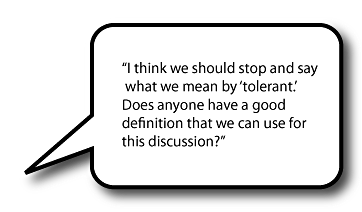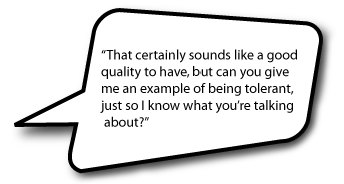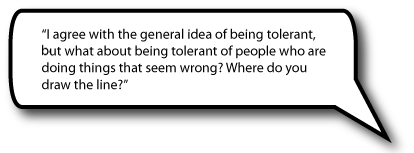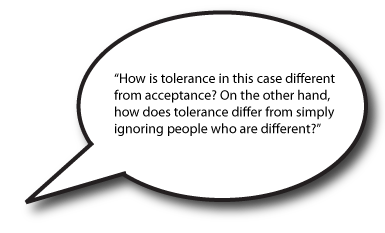Introduction
Both interviews and discussions are different from speeches because in interviews and discussions you must respond to what another person says. For an interview, you cannot prepare what you are going to say beforehand or practice your delivery. If you are not focused every moment, you will not be a good interviewer or a good discussion participant.
One of the most important assets you can bring to interviews and discussions is your own curiosity. Maybe you don’t think of curiosity as an asset, but it can be useful to access your curiosity as you speak. As a warm-up for this lesson, take two minutes to write as many questions as you can about the statement below. Use your Take Notes Tool. When you are finished, check your understanding to see some possible responses.

The statement:
I like tropical fish.
You are on your honor to stop writing after two minutes. Go!
Possible questions: Do you have tropical fish? How do you take care of them? Where did you get them? Are all tropical fish saltwater fish? What do you feed them? What breed or species is your biggest fish? Have you ever seen them in a natural setting? Which fish do you like the best? What kind of fish do you think is most beautiful? What gives you the greatest pleasure about having fish? How much have you learned about your tropical fish? Does knowledge about them make you enjoy them more? Do you know other people who have tropical fish? Do you subscribe to magazines or read books about tropical fish? Do you collect art that depicts tropical fish? What annoys you about them? Could you see yourself making an occupation of caring for or selling tropical fish rather than just caring for them as a hobby? Would you like to take academic classes in fish biology? Do you know people who are uninterested in fish? Do you like it when people show interest in your hobbies? Have you ever made friends with someone because you were both interested in fish? Have you ever lost a fish?
CloseAmong your own questions and the examples, notice that not every question is right for every interview or discussion. Tropical fish could come up as a topic in many contexts. But your curiosity will give you a wealth of questions from which to choose.
Exploring a Topic

Five people get together to discuss the role of tolerance in a
good life.
The first person says, “I think that everyone who wants to lead a good life has to be tolerant of people who are different.”
The second person says, “I think you are right.”
The third person says, “I don’t see how anyone would disagree with that.”
The fourth person says, “In my own life, I’ve found what you say to be true.”
The final person says, “This has been a great discussion.”
This was, of course, not a good discussion at all. It was a terrible discussion.
Why?
Nobody explored the topic.
Agreement is often not the reason we enter into a discussion. Sometimes it’s better to avoid agreement if it involves too much compromise. When people compromise, they each give up a little so the group can form a unified position on the topic. Compromise is nice in business and politics but need not be a part of an academic discussion.
The purpose of academic discussion is to uncover as many aspects of a topic as possible and to include as many reasonable points of view as possible. To put it another way, the purpose of a discussion is to keep the conversation going in a reasonable way. Differences in how people approach a topic are what make a discussion useful.
Now let’s think about how the discussion at the beginning of this section could be improved. What if the second person had responded differently and said:
“I think that everyone who wants to lead a good life has to be tolerant of people who are different.”
- Now read how the third person responded to this comment. Decide if the response to “I think that everyone who wants to lead a good life has to be tolerant of people who are different” is a good contribution. Would the response help to explore the topic, expand the discussion, and open up new possibilities? When you have an answer in mind, check your understanding.
- Now read another possible response to the second speaker. Again, would the response help to explore the topic, expand the discussion, and open up new possibilities? When you have an answer in mind, check your understanding.
- Let’s look at another possible response to “I think that everyone who wants to lead a good life has to be tolerant of people who are different.”
- What about this comment? Is it a useful response to “I think that everyone who wants to lead a good life has to be tolerant of people who are different”?
Third person’s response:

1. This is a superb comment. Notice that the speaker asks for a definition, but that he or she does not ask someone to look up the word in the dictionary (though if the topic had contained an uncommon word, a dictionary definition might have been helpful). The definition for “tolerant” may not need to conform to definitions in other contexts, but the people in the discussion must agree on the term within the discussion.
CloseThird person’s response:

2. This is a good reply. Notice that the speaker is polite. Discussion is not fighting. Also notice that the speaker asks for more information from the person who spoke first. In a discussion, each speaker requests as much input as he or she contributes. Good discussions require give-and-take. They are based on mutual interest, and interest leads you to find out what you don’t already know. It’s hard to be interested in something if you have already made up your mind about it.
CloseThird person’s response:

3. This is another superb comment. Notice that the speaker states some agreement. This makes it easier for others to hear the disagreement that comes next. Also notice that the speaker is polite. (The speaker could have said: “Are you crazy? Are we supposed to be tolerant of violent criminals?”) Finally, notice that the speaker asks others to consider the question, rather than demanding an up or down vote. “Where do we draw the line?” invites further discussion.
CloseThird person’s response:

4. This is an excellent comment. Notice that the speaker brings some new elements into play. The speaker introduces some contrasting attitudes which can be used to bring tolerance into sharper focus.
CloseIf we look over these comments, we find that several key attitudes are valuable in discussions:
- Be polite. Don’t start a fight.
- Ask for more information. Be interested.
- Focus on the main terms in the topic. Ask for agreement on definitions.
- Bring in new elements to challenge assumptions and reveal inconsistencies.
- Pursue the conversation with an open mind. Do not make moves that halt the conversation.
Staying on Topic
 Image © 2007, mtsofan
Image © 2007, mtsofan
It is crucial to keep the conversation going but also to keep it reasonable. Getting off topic can bring down a discussion very quickly. Sometimes losing the topic is completely unintentional, and the conversation may only need one of the participants to redirect. You might try saying, “That’s interesting. But let’s get back to the question that Steven asked a minute ago.”
Read the comments that follow in this activity. They are a continuation of the discussion from the last section. The topic is still the importance of tolerance as part of a good life. Which of these comments should be encouraged with a statement such as, “That’s interesting. Can you say more about that” and which comments should be followed by a redirection such as, “That’s interesting. But let’s get back to the question that Steven asked a minute ago.”
Click on the comment you think should come next for each of these examples. The correct response will turn green and the incorrect response will turn red; check your understanding after each possibility for a further explanation.
- “I had an aunt who was lactose intolerant her whole life. I don’t know if that is genetic. I guess it’s possible that at some point I may have to give up milk products. I’d hate to have to give up ice cream.”
- “That’s interesting. Can you say more about that?”
- “That’s interesting. But let’s get back to the question that Steven asked a minute ago.”
- “I grew up with parents who had a sense of everyone being equal. They would often talk about how we should treat everybody respectfully, no matter what. But they would tell me there were certain kids that they didn’t really want me to bring back to the house. It was very confusing to me. They thought they were tolerant, but I don’t think they were.”
- “That’s interesting. Can you say more about that?”
- “That’s interesting. But let’s get back to the question that Steven asked a minute ago.”
- “Doesn’t tolerance imply that you don’t like something? You wouldn’t say that you are tolerant of opera if you really liked opera in the first place. In other words, isn’t tolerating your neighbor a long way short of loving your neighbor? How does tolerance square with the golden rule?”
- “That’s interesting. Can you say more about that?”
- “That’s interesting. But let’s get back to the question that Steven asked a minute ago.”
- “I’m sick of people being tolerant and saying that I should be tolerant. I think way too much harm is done in the world by people who want to be tolerant. I think we should have some indignation about the way things go wrong in the world.”
- “That’s interesting. Can you say more about that?”
- “That’s interesting. But let’s get back to the question that Steven asked a minute ago.”
Where should the discussion about “tolerance as part of a good life” go now?
Answer B is correct. The statement should be redirected because it is about a different kind of tolerance entirely. It would be difficult to find a productive way to bring it into the discussion about a good life.
CloseWhere should the discussion about “tolerance as part of a good life” go now?
Answer A is correct. This is a valuable contribution. Many productive replies could follow this. Someone might observe how actions are more revealing than words. Or someone could ask the speaker how this affected his or her attitude toward the “unwelcome” friends. There is definitely more to say on the information introduced here.
CloseWhere should the discussion about “tolerance as part of a good life” go now?
Answer A is correct. This is a valuable contribution that could take the discussion in several directions. Someone might want to explore the truth of this contribution; does tolerance really imply not liking something? Someone else might want to say that tolerance is at least a first step, even if it does imply dislike—so need it be an end point? Yet another party to the discussion might discuss how far we can take the golden rule and what the different forms of the golden rule mean in different cultures.
CloseWhere should the discussion about “tolerance as part of a good life” go now?
Answer A is correct. This is a valuable contribution as long as the speaker’s tone of voice is not combative. The reply raises some very important questions: Does tolerance resign people to the status quo? Does tolerance lead to cultural stagnation? The crucial element is that people who raise such questions are interested in other ideas and are willing to change their minds. If they don’t want to have any of their ideas changed, they should not participate in the discussion.
CloseThere are two reasons to redirect back to the previous comment: 1) to stop a digression or 2) to postpone a valuable, but new, topic.
Chased by a Bear
Most of what we’ve said about group discussions also applies to interviews: Keep the conversation going. Don’t pick a fight. Ask for definitions and examples. Ask about new elements and contexts and how they would change the topic. But in the interview situation, be more open to the person to whom you are speaking—the interviewee.
Interviews usually have a topic, but the topic is not primary. The person’s position is what the interview is about. That means that your role as interviewer is diminished. In a discussion, the spotlight shifts from person to person, but in an interview the spotlight is always on the person being interviewed. Your responsibility is to keep the person talking, to make sure that the spotlight is justified.
In addition to the guidelines above, remember to follow up. Amateur interviewers may fail to follow up. This is actually a failure to pay attention, a lapse of listening.
Take this interview, for example, that a student had with her father.

Student: “Dad, can you tell me about your most vivid memory from being in college?”
Father: “That’s easy. The thing I remember most vividly was when I was chased by a bear.”
Student: “And can you tell me what your major was?”
We have to assume that the student had a list of questions and was proceeding down her list one by one without listening to answers. She couldn't have been listening or she would not have gone from “the time I was chased by a bear” to “What was your major?” She could have said just about anything concerning the bear to show that she was listening, and her dad would probably have continued the story. Even saying “Huh?” would have produced a better interview.
For the next activity, read the interchanges below and decide which of the follow-ups are good moves and which are bad moves. Which ones draw more out of the person being interviewed, and which of them shut the person down? When you click on the correct answer, it will change to green; the incorrect answer will turn red. Check your understanding to read more about the correct answer.
Interchange 1:
Person being interviewed: “As a boy, I was in charge of slaughtering a hen whenever my mother wanted to make fried chicken.”
Interviewer: “Did she make biscuits to go along with the chicken?”
- Good move
- Bad move
Bad move. This reply by the interviewer only follows up on part of the comment—and not the most important part. The initial statement is significant because a boy is killing a chicken. Biscuits are beside the point. How did he kill the chicken? Did it bother him? Could he do it now? Would he want his own children to do such things?
CloseInterchange 2:
Person being interviewed: “I have always been afraid of big dogs. When I see someone walking a big dog, I cross to the other side of the street. To avoid a big dog, I will actually go into a store even if I have no intention of buying anything.”
Interviewer: “Can you remember when you first reacted this way to seeing a big dog? Did you ever have any bad experiences with big dogs? How about small dogs? Are those also a problem?”
- Good move
- Bad move
Good move. This reply by the interviewer follows up on the most important aspect of what was said. Note: The interview asks several questions stacked on top of each other. In an actual interview, you would probably ask these one by one.
CloseInterchange 3:
Person being interviewed: “I’ve studied snakes for most of my career, and they have never made me afraid. I can understand why people want them as pets. I find them very beautiful and also like the feel of their bodies. But I think it’s a mistake to attribute emotions to them. I don’t believe that snakes ever come to know, let alone love, people who keep them as pets.”
Interviewer: “But isn’t it possible that a snake can come to know, even to love, the situation that it finds itself in? Are there cases when a snake has seemed to prefer living as a pet rather than freeing itself?
- Good move
- Bad move
Good move. This reply pushes the person being interviewed in a particular direction. The next response may be "I have never seen that happen“ or "I’m not sure." But the question is an interesting one, and the person being interviewed might use it as a way to jump to another issue.
CloseInterchange 4:
Person being interviewed: “Monkeys in captivity can be very happy. Apes, on the other hand, always protest captivity. They would always prefer to be in the wild.”
Interviewer: “I think capuchins are sometimes trained as companions for people who are disabled. Is that sort of training possible with all monkeys, or are capuchins an exception?
- Good move
- Bad move
Good move. Notice that the interviewer either knows a lot about primates or (more likely) did some homework before the interview. Amateur interviewers often forget that preparation is important. Whether the interview is for a writing assignment or for a job, it will be more productive if both people start with a knowledge base. Curiosity will only take you so far.
CloseModel Interview
 Caption needed
Caption needed
Here’s a link to an interview by Dave Davies for “Fresh Air,” a radio show on NPR produced at WHYY in Philadelphia. For this activity, you will use a graphic organizer. You can save, download, and print this file.
Open the graphic organizer and read over the instructions, and listen to the interview embedded in the PDF or at the NPR website. Listen closely to the interview for the information you will need to fill in the organizer.
Listening to the audio and working with the graphic organizer showed you how an expert conducts an interview. Remember that several things are important to any interview situation:
- Listen to the answers you get and follow up when necessary.
- Do your homework. Find out what you can before the interview both about the topic and about the person you are going to interview.
- Keep the person talking. Be curious. Demonstrate interest even if you just nod your head or use short verbal prompts.
- Change topics only when you feel the current topic has been covered, keeping in mind that a follow-up question sometimes provides the most interesting information when it seems as though the final word has been said.
Resources
Resources Used in this Lesson: Bibliography
Laufer, Peter. “Raising Lions, Tigers, Bears in Suburbia (Oh My!)” By Dave Davies.Fresh Air radio program. July 15, 2010. http://www.npr.org/templates/story/story.php?storyId=127773104.